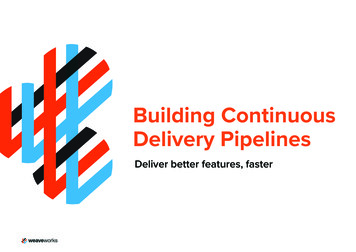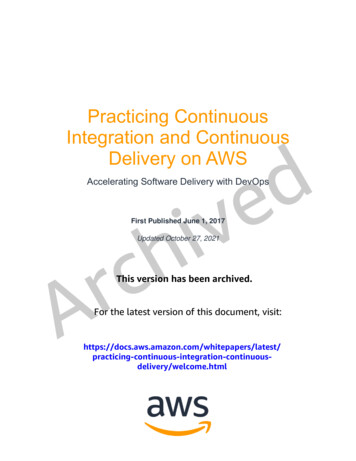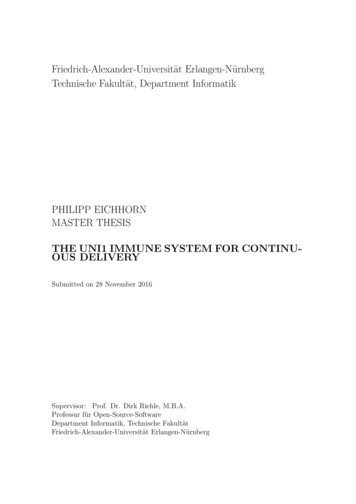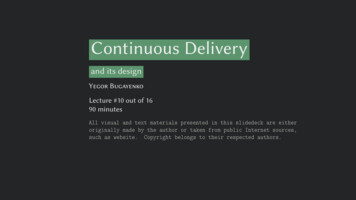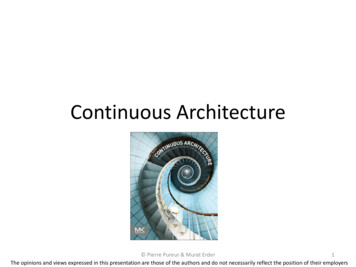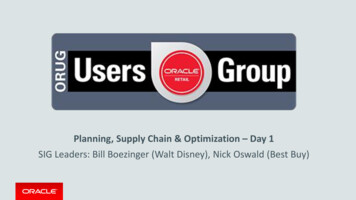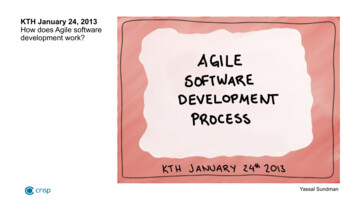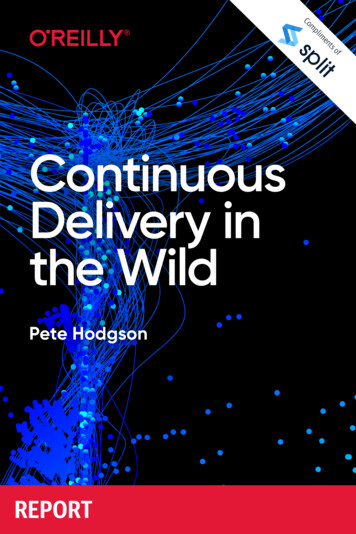
Transcription
ComplimentsofContinuousDelivery inthe WildPete HodgsonREPORT
Skip the hotfixes and rollbackswith Split’s Feature Delivery Platform.
Continuous Deliveryin the WildPete HodgsonBeijingBoston Farnham SebastopolTokyo
Continuous Delivery in the Wildby Pete HodgsonCopyright 2020 O’Reilly Media. All rights reserved.Printed in the United States of America.Published by O’Reilly Media, Inc., 1005 Gravenstein Highway North, Sebastopol, CA95472.O’Reilly books may be purchased for educational, business, or sales promotional use.Online editions are also available for most titles (http://oreilly.com). For more infor‐mation, contact our corporate/institutional sales department: 800-998-9938 orcorporate@oreilly.com.Acquisitions Editor: John DevinsDevelopmental Editor: Sarah GreyProduction Editor: Nan BarberCopyeditor: Christina EdwardsFebruary 2020:Proofreader: Nan BarberInterior Designer: David FutatoCover Designer: Karen MontgomeryIllustrator: Rebecca DemarestFirst EditionRevision History for the First Edition2020-02-11:First ReleaseThe O’Reilly logo is a registered trademark of O’Reilly Media, Inc. Continuous Deliv‐ery in the Wild, the cover image, and related trade dress are trademarks of O’ReillyMedia, Inc.The views expressed in this work are those of the authors, and do not represent thepublisher’s views. While the publisher and the authors have used good faith effortsto ensure that the information and instructions contained in this work are accurate,the publisher and the authors disclaim all responsibility for errors or omissions,including without limitation responsibility for damages resulting from the use of orreliance on this work. Use of the information and instructions contained in thiswork is at your own risk. If any code samples or other technology this work containsor describes is subject to open source licenses or the intellectual property rights ofothers, it is your responsibility to ensure that your use thereof complies with suchlicenses and/or rights.This work is part of a collaboration between O’Reilly and Split Software. See ourstatement of editorial independence.978-1-492-07767-1[LSI]
Table of Contents1. Introduction. . . . . . . . . . . . . . . . . . . . . . . . . . . . . . . . . . . . . . . . . . . . . . . . 1What is Continuous Delivery?Continuous Delivery in the Real WorldResearch MethodologyThe Path to Production12232. Branch Management and Code Review. . . . . . . . . . . . . . . . . . . . . . . . . 7GitHub FlowTrunk-Based DevelopmentMinimal BranchesCutting a Release Versus Promoting a BuildCode ReviewReducing Batch Size788910113. Running an Integrated System. . . . . . . . . . . . . . . . . . . . . . . . . . . . . . . 15Continuous Delivery Demands Fewer EnvironmentsTesting Changes Prior to Merge15164. Deployment and Release. . . . . . . . . . . . . . . . . . . . . . . . . . . . . . . . . . . . 21Single-Piece FlowRelease BusesCoordinating Production ChangesControlled RolloutIncremental DeploymentDecoupling Deployment from ReleaseCorrelating Cause and EffectMoving Fast with Safety2121222424252526iii
5. Summary. . . . . . . . . . . . . . . . . . . . . . . . . . . . . . . . . . . . . . . . . . . . . . . . . 27Shared ValuesTwo Modes of Continuous DeliveryMonoliths Versus SOASucceeding with Continuous Deliveryiv Table of Contents27282929
CHAPTER 1IntroductionSoftware companies are under constant pressure to deliver featuresto their users faster, while simultaneously maintaining (or improv‐ing) the quality of those features. This may seem like an impossibletask, but many organizations have discovered that it is in fact ach‐ievable, using the practices of Continuous Delivery.What is Continuous Delivery?Continuous Delivery is a set of technical practices that allow deliv‐ery teams to radically accelerate the pace at which they deliver valueto their users. The core tenet of Continuous Delivery is keepingyour codebase in a state where it can be shipped to production atany time. By working in this way, you can quicken the tempo of pro‐duction changes, going from infrequent, big, and risky deploymentsto deployments that are frequent, small, and safe.The book Accelerate, by Nicole Forsgren, PhD, JezHumble, and Gene Kim, uses rigorous scientific meth‐ods to confirm many of the benefits of ContinuousDelivery, based on several years of the State Of DevopsSurvey. The book shows that organizations practicingContinuous Delivery have better software delivery per‐formance, which in turn drives greater organizationalperformance. In other words, Continuous Deliveryleads to better organizational outcomes.1
Continuous Delivery in the Real WorldA lot of the discussion around Continuous Delivery focuses on thecutting-edge practices advancing the state of the art. In this report,we will instead look at how a variety of organizations have imple‐mented Continuous Delivery in the real world.We’ll look at some of the common approaches these organizationshave found helpful. We’ll also see how there are multiple ways toachieve the same goal, depending on the organizational context. Myhope is that after reading this report you’ll come away with someactionable ideas for how to implement, or improve, ContinuousDelivery within your own organization.Research MethodologyTo understand how people have implemented Continuous Deliveryin the real world, I conducted in-depth interviews with a variety oforganizations with a rapid software delivery tempo, deploying codeinto production at least daily. Some of these organizations havepracticed something akin to Continuous Delivery from the start,while others have migrated to Continuous Delivery practices overthe last few years.Throughout the rest of the report, I’ll refer to the organizationsinterviewed as “participants.” The more interesting participants aredescribed as follows:Payment ProcessorFounded in 2009, with around 1000 engineers and ServiceOriented Architecture (SOA) consisting of around 500 services.Automotive MarketplaceHas had an online presence since the mid-1990s, with around200 engineers and an architecture that’s migrating from mono‐lithic web apps toward SOA, with currently around 300 services.Online RetailerFounded in the 1950s, with around 20 engineers working on amonolithic web application, which is just starting to movetoward SOA.2 Chapter 1: Introduction
Food Delivery ServiceFounded in 2012, with around 30 engineers working on an SOAof 15 to 20 services.Healthcare ProviderFounded in 2007, with around 100 engineers working on amonolithic web application.Print and Design ServiceFounded in 2004, with around 50 engineers who are partwaythrough a migration from a monolithic web application to SOA,with currently around 50 services.Online RealtorFounded in 1995, with around 450 engineers working on anSOA made of up of both large monolithic systems and smallerservices.Financial Services StartupFounded in 2007, with around 800 engineers working on anSOA with a large number of small services.We’ll learn more about how each of these organizations hasapproached the challenges of Continuous Delivery throughout thereport.The Path to ProductionTo understand how each participant does software delivery, I askedthem to describe the “path to production” for a small user-facingfeature. While the organizations vary broadly in terms of architec‐ture, industry, and organization size, there is a striking consistencyin the mechanics of how each organization has implemented Con‐tinuous Delivery.Across all the organizations that I surveyed, the path to productionlooks something like this (Figure 1-1): Engineer implements feature Change is reviewed and merged to master Change is validated via automated tests Change is automatically deployed to a shared integrationenvironmentThe Path to Production 3
Brief exploratory testing of change is done (if warranted) Change is deployed to production Controlled rollout of the change to users happens (if warranted)Figure 1-1. The path to production: how a feature moves from an engi‐neer’s keyboard into a user’s handsThe first half of this path—building the feature, merging it, and per‐forming automated validation of the merged code—constitutes thepractice of Continuous Integration. The second half—flowing thechanges that make up the new feature through to production in asafe, consistent way—constitutes Continuous Delivery.We’ll explore how different organizations implement this path toproduction over the course of this report.Continuous Delivery Versus Continuous DeploymentEvery organization I surveyed has an automated deployment frommaster1 to a shared preproduction environment. Any change thatlands on master will automatically be deployed to the preproduc‐tion environment, as long as it passes Continuous Integration vali‐dation.This approach is taken even further at the Online Realtor and theAutomotive Marketplace, where some teams automatically promotechanges to their production environment, with no human interven‐tion necessary, as long as it passes further automated validation.This is an example of Continuous Deployment—every valid change1 Going forward, I’ll use “master” as a shorthand for the main development branchwhere a team integrates their work, since that’s the most common nomenclature intoday’s git-centric world. This is sometimes referred to as “trunk” (i.e., in Trunk-BasedDevelopment).4 Chapter 1: Introduction
landing on master will automatically flow all the way through toproduction.However, most of the organizations that I talked with avoid full-onContinuous Deployment. Instead, they institute some sort of man‐ual gate, requiring an engineer to explicitly promote their changesinto production from a preproduction environment. This wouldn’tbe considered Continuous Deployment, but it is still a form of Con‐tinuous Delivery.The Path to Production 5
CHAPTER 2Branch Managementand Code ReviewContinuous Delivery builds upon the practice of Continuous Inte‐gration, which is defined by the frequent integration of work into ashared branch (with “frequent” often interpreted as “at least daily.”1)All participants I interviewed adhere to these principles, avoidinglong-lived feature branches almost entirely.However, many participants are not meeting the strict definition ofContinuous Integration. Several reported that feature branches havea typical lifetime of a few days to a week before being integrated intotheir shared master branch.2GitHub FlowThe majority of participants use a variant of the GitHub flowbranching model.3 Engineers create a short-lived feature branch foreach change they are implementing, and create a pull request (ormerge request) once their work is ready to be integrated into master.1 Accelerate, Chapter 4.2 All participants were using Git for version control.3 GitHub flow is defined here: https://oreil.ly/ocvBZ. While this definition specifies thatchanges in a feature branch are deployed to production before being merged to master,I have yet to encounter an organization that actually does this—besides GitHub them‐selves, presumably.7
That pull request typically also serves as a mechanism for coordinat‐ing code review. Once a change has been approved it is merged intomaster.Participants using pull requests also typically leverage their Contin‐uous Integration infrastructure to run premerge validation, runningthe same types of automated checks against the feature branch asthey would run against master once the branch is merged. Feedbackfrom these automated checks is then available for reviewers of thechange within the pull request UI.Trunk-Based DevelopmentSome participants forgo the use of branches entirely and workdirectly on master, a practice known as Trunk-Based Development.Engineers at the Online Retailer explained that they simply maketheir changes directly to their local master branch, and push to theshared remote repository once their changes are ready.Participants that primarily use Trunk-Based Development do stilluse short-lived feature branches on occasion. The Online Retailerdescribed using them when a change was risky, or being made by ajunior engineer. At the Automotive Marketplace, they are used whenan engineer from one team is making changes to a codebase ownedby another team. In that case the engineer would create a featurebranch and use a pull request to solicit feedback from the owningteam before landing the change into their master branch.Minimal BranchesAcross all participants there was universal agreement that long-livedbranches are detrimental to Continuous Delivery practices. Someparticipants that had recently moved to Continuous Delivery werestill in the process of moving away from relying on long-livedbranches.What were these legacy long-lived branches used for? At the Health‐care Provider and the Print and Design Service, there were some lin‐gering instances of team integration branches, a shared branch usedby engineers on a team in order to collaborate on a hairy codechange that would have destabilized their master branch. TheOnline Retailer had another use case, where a long-lived releasebranch was still part of their release engineering process. In all cases,8 Chapter 2: Branch Management and Code Review
participants were experiencing pain from these practices. Team inte‐gration branches are inevitably (and ironically) hard to integratewith the shared master branch. Release branches have a variety ofdrawbacks, as we’ll discuss next.Cutting a Release Versus Promoting a BuildTraditionally, teams have used branches to orchestrate a softwarerelease. The first step in getting a set of changes into productionmight involve “cutting a release branch” off of the master branch.That release branch freezes the version of the codebase that will bedeployed to production (often referred to as a release candidate).This release candidate is isolated from potentially destabilizingchanges, which will continue to land on the master branch while thevarious phases of a production release take place against the releasebranch.Modern CI/CD systems provide a better alternative to releasebranches: the Delivery Pipeline. This moves the orchestration of arelease out of source control and into the CI/CD system itself. Apipeline defines the various stages required to take a version of oursource code, gain confidence in it, and eventually deploy it into pro‐duction. These stages all operate on a static snapshot of the code‐base, which provides the same type of isolation as a release branch.No matter what changes happen in version control after a pipelinestarts, each stage of the pipeline always works with the exact sameversion of the codebase.Because it’s working against a static snapshot of our code, a deliverypipeline allows us to gain more and more confidence in that particu‐lar version of our code. As it moves through the various stages ofour pipeline it is subjected to a series of automated checks as it isdeployed into preproduction environments for further validation.When the change is eventually deployed into production we can beconfident that what’s being deployed is the same code that has suc‐cessfully surmounted the obstacle course of quality checks putbefore it earlier in the pipeline. This is in contrast to a releasebranch, which often receives additional small changes (configura‐tion updates, bug fixes, and so on) as a release candidate movesthrough the release process.Another advantage of delivery pipelines is that they force a team toautomate the various operations involved in a release. With aCutting a Release Versus Promoting a Build 9
traditional release branch approach, there is often a series of manualsteps involved in a production release—cut a branch, update config‐uration files to indicate that this is a release build, and merge anyhot-fix changes back into master. These manual steps add additionalfriction to each release, as well as introduce a high risk of humanerror—configuration changes inconsistently applied, bug fixes lostafter a release, and so on.For these reasons, most participants use delivery pipelines, ratherthan release branches. The few still using release branches, such asthe Online Retailer and the Healthcare Provider, are actively movingtoward the use of delivery pipelines.Most CI/CD systems also provide a manual gating feature, whichprevents a pipeline from moving on to the next stage until it receivesapproval to do so from a human operator. This feature is often usedto pause a pipeline right before a release candidate is deployed toproduction. For any successful run of the pipeline, an engineer canopt to “push the button” and deploy a change to production, typi‐cally after a quick spot-check of the change in a pre-productionenvironment. This act of approving a release candidate to move tothe next environment is often referred to as “promoting” the build.The presence of a manual gate is what distinguishes ContinuousDelivery from Continuous Deployment, as discussed in Chapter 1.Code ReviewAll participants using short-lived feature branches also use pullrequests to orchestrate their code review process. Several require achange to be reviewed before it can be merged to master—a regula‐tory requirement for some—although the majority of participantsdon’t systematically enforce this policy. Several teams reported chal‐lenges with code review turnaround time. A delay in a change beingreviewed often leads to an increase in feature branch lifetime, butalso tends to decrease engineer productivity as they attempt to jug‐gle multiple branches, working on a new change while waiting foran existing change to be approved for merge.Participants that work directly on master are more varied in theircode review practices. Teams at the Automotive Marketplace tend toconduct code review in person, prior to pushing changes to a sharedmaster, either via pair programming or “over-the-shoulder” inperson walkthrough. However this type of premerge code review is10 Chapter 2: Branch Management and Code Review
typically only reserved for changes considered large or risky. Teamsat the Online Retailer practice postmerge code review, managed viatheir project management tool, with review feedback captured viacommit annotations in GitHub. Whether practicing pre- or post‐merge review, teams working directly on master don’t have a strictpolicy that all changes should be reviewed.Reducing Batch SizeEngineers at the Financial Services Startup describe its deliverypipeline as being like a moving assembly line in a factory. If smallchanges are constantly showing up on the conveyor belt (i.e., smallchanges landing on master) then there is enough time to inspecteach change, and the team feels comfortable with those changesflowing out to production (Figure 2-1). It is clear that teams work‐ing directly on master find it much easier to achieve this flow ofsmall changes.Figure 2-1. A steady flow of small changes moving along the linetoward productionHowever, if a feature branch is allowed to live too long before merg‐ing then a large batch of changes accumulates (as shown inFigure 2-2), making it hard to inspect each change once it lands onthe assembly line.Reducing Batch Size 11
Figure 2-2. A big change landing on the line is harder to inspectSimilarly, if production deployments are held up for any reason—aproduction issue, or bugs found on master—then again a large set ofchanges will accumulate (Figure 2-3).Figure 2-3. Lots of pending changes backed up in staging are alsoharder to inspectSeveral participants explicitly identified small batch size as a key tomaking Continuous Delivery possible. Their software delivery pro‐cesses were contingent on a steady flow of small changes into pro‐duction. Given this, I asked participants what techniques they usedto reduce the size of each change going out to production, while alsoavoiding exposing half-finished changes to end users.44 Paul Hammant has assembled an exhaustive collection of “Trunk-Correlated Practices”:https://oreil.ly/63jQp.12 Chapter 2: Branch Management and Code Review
Rather than releasing a feature as one large code change, teamsspend time breaking a feature down into a set of smaller changes.These changes are also sequenced so that they can be built anddeployed into production one by one as latent code—code that istested and in production, but not exposed to users.Incremental Feature DeploymentLet’s look at a simplified example of how you might safely deploy ahalf-finished feature into production.You’re a product engineer for an online store, and you’re workingon adding a “request gift wrap” feature. This will require adding anew checkbox in the checkout UI, along with adding a correspond‐ing new field in the backend API that that checkout UI uses, as wellas further changes deep in the bowels of the order fulfillmentsystem.You slice the engineering work up into a set of smaller changes thatwill be deployed independently. You work on the backend changesfirst, and deploy them to production. After deployment, the back‐end API supports gift wrapping requests, but no users can makethat request since the checkbox has not been added to the UI. Thisallows you to safely verify that the core functionality works in pro‐duction. Once you are comfortable, you make the final change,adding the checkbox to the UI, exposing the new feature to users. Ifyou want extra safety, you might wrap that UI change in a featureflag, a technique we’ll discuss further in Chapter 4.The Food Delivery Service uses branch by abstraction techniques asa way to avoid long-lived feature branches. A large internal changeis implemented as latent code alongside the existing implementa‐tion, along with some internal plumbing that allows switchingbetween the old and new implementation at runtime, typically con‐trolled by a feature flag. Using this approach, large changes can bemade incrementally on master, tested along the way, but only“turned on” once they’re complete.Interestingly, several participants shared stories of tight-knit teamsworking on a smaller codebase who would, at times, opt to simplydeclare master temporarily unstable and put production deploy‐ments on hold while working on a large feature that was tricky tobreak apart. The Food Delivery Service noted that in these cases aReducing Batch Size 13
team with mature Continuous Delivery practices was opting to“know the rules well enough to break them.” While a key tenet ofContinuous Delivery is that master should always be in a releasablestate, these teams decided that in some cases the trade-off was worthit, as opposed to taking on the additional overhead of a full-blownbranch by abstraction process.14 Chapter 2: Branch Management and Code Review
CHAPTER 3Running an Integrated SystemIn Chapter 2 we saw that participants strive for a continuous flow ofsmall changes into production. This leads to two outcomes. First,preproduction environments become less useful. Second, engineershave to test their changes against an integrated system before merg‐ing those changes to master.Continuous Delivery Demands FewerEnvironmentsParticipants that had recently moved to Continuous Delivery, suchas the Online Retailer, described a pre-CD world where engineersand testers relied on multiple fully integrated preproduction envi‐ronments—environments running the full stack of software consti‐tuting the product, in a similar physical architecture to production(although often at a smaller scale). These preproduction environ‐ments are used for different use cases: developer sandboxes, integra‐tion testing, exploratory testing, showcasing, and so on.Multiple environments were necessary because these different activ‐ities required different versions of various codebases to be integratedfor inspection. For example, product manager might want to pre‐view an upcoming release in an environment running the currentrelease candidate for every codebase (a release candidate being theversion that has been identified as ready for release to production,pending quality checks). An engineer might also want to work on anew integration between two services by pointing a locally running15
service to some feature branch version of a dependent service, run‐ning in a shared development environment. A tester might want tovalidate a production hotfix—a minor release made outside of regu‐lar release cadence in order to apply an urgent production change—by running the hotfix change against the production versions ofother systems.These myriad different versions of different systems become lessimportant when practicing Continuous Delivery. Because the pro‐duction system is changing so frequently, it’s only really interestingto look at what’s currently in production, or what’s about to be inproduction. To that end, many participants report operating just twofully integrated environments: production itself and a shared preproduction environment, which I’ll refer to as “staging.”1 Asdescribed in Chapter 1, the Continuous Delivery infrastructureensures that staging always contains the latest good version fromeach codebase’s master branch, with the versions deployed in theproduction environment typically lagging behind staging by a day ortwo at most.Testing Changes Prior to MergeA central tenet of Continuous Delivery is that master should alwaysbe releasable. This poses a paradox for an engineer: you want to testhow the changes that you’re making work when integrated with therest of the system, but you don’t want to merge those changes tomaster before they’ve been validated.The participants resolved this paradox by: Running a full environment locally Running a partial environment locally, with stubbed outdependencies Running a partial environment locally, integrated against ashared environment Issuing a personal development environment to each engineer1 The nomenclature for environments is rather inconsistent across organizations. I’vetypically seen the type of environment I’m referring to here as “stage,” “staging,” or “preprod.”16 Chapter 3: Running an Integrated System
Allowing engineers to stand up transient development environ‐ments on-demand Allowing engineers to inject custom versions of a service into ashared environmentRunning a Full Environment LocallyWhen working with a monolith (or smaller SOA systems) it can bepossible to run the entire product locally on a developer workstation(Figure 3-1). Doing this allows you to assemble whatever set of ver‐sions is appropriate for the work at hand. However, as the number ofservices in a product architecture grows beyond a certain size thisapproach becomes infeasible.Figure 3-1. Debbie Dev running the full product stack locallyRunning a Partial Environment LocallySome participants, such as the Food Delivery Service and the Pay‐ment Processor, invested a fair amount of engineering effort inensuring that individual services can stand up in isolation. Thismeant that an engineer working on a service could stand up just thatservice locally, or if necessary they could stand up that service plusthe services it depended upon (Figure 3-2). Those depended-uponservices would run in an isolated manner, preventing the entiregraph of transitive dependencies from being pulled in.Testing Changes Prior to Merge 17
Figure 3-2. Debbie Dev running a partial stack locallyIssue Personal Dev EnvironmentsWhen the Healthcare Provider’s architecture became too large torun locally, they opted to instead stand up a full-stack remote devel‐opment environment for each engineer (Figure 3-3). An engineer isresponsible for maintaining her environment, and can deploy differ‐ent versions of services in that environment using custom tooling(command-line scripts and/or a web interface). This approachinvolves significant management overhead, as well as a nontrivialinfrastructure cost.Figure 3-3. Debbie Dev’s personal dev environmentAllow Transient, On-Demand Dev EnvironmentsThe Print and Design Service and the Financial Services Startupopted for an alternative approach, where engineers can do selfservice provisioning of short-lived, full-stack environments, and18 Chapter 3: Running an Integrated System
then manage them similarly to the personal dev environmentsdescribed above.With this approach, environments are automatically torn downevery night. This reduces infrastructure cost, and also reduces theamount of ongoing configuration and version drift. However, theseprovisioning systems also allow engineers to request a “stay of exe‐cution,” which in some cases leads to the establishment of long-livedenvironments serving as a sort of shared team integrationenvironment.Allow Connecting Development Workstations toStagingAt the Automotive Marketplace, engineers can integrate a servicerunning on their local development workstation directly into theshared staging environment (Figure 3-4). This can work well whenthe locally running service depends on one or more other service,but doesn’t allow you to test the inverse integration, where otherservices depend on your locally running service.Figure 3-4. Debbie Dev connecting a locally running service intostagingOverriding Service Versions in StagingThe Food Delivery Service and the Payment Processor also provideengineers with the ability to override the version of a service run‐ning in the shared staging environment (Figure 3-5). An engineercan take a feature branch build of a service (that has not yet landedon master) and temporarily deploy that build into a staging environ‐ment. This capability is used sparingly—typically when an engineerTesting Changes Prior to Merge 19
has a particularly risky or complex change—but is very valuablewhen needed.Figure 3-5. Debbie Dev temporarily overriding the version of her ser‐vice in staging20 Chapter 3: Running an Integrated System
CHAPTER 4Deployment and ReleaseAll the participants I surveyed are making production deploymentsat least daily. In this chapter we’ll look at the techniques they use toachieve
The book Accelerate, by Nicole Forsgren, PhD, Jez Humble, and Gene Kim, uses rigorous scientific meth‐ ods to confirm many of the benefits of Continuous Delivery, based on several years of the State Of Devops Survey. The book shows that organizations practicing Continuous Delivery have better software delivery per‐


